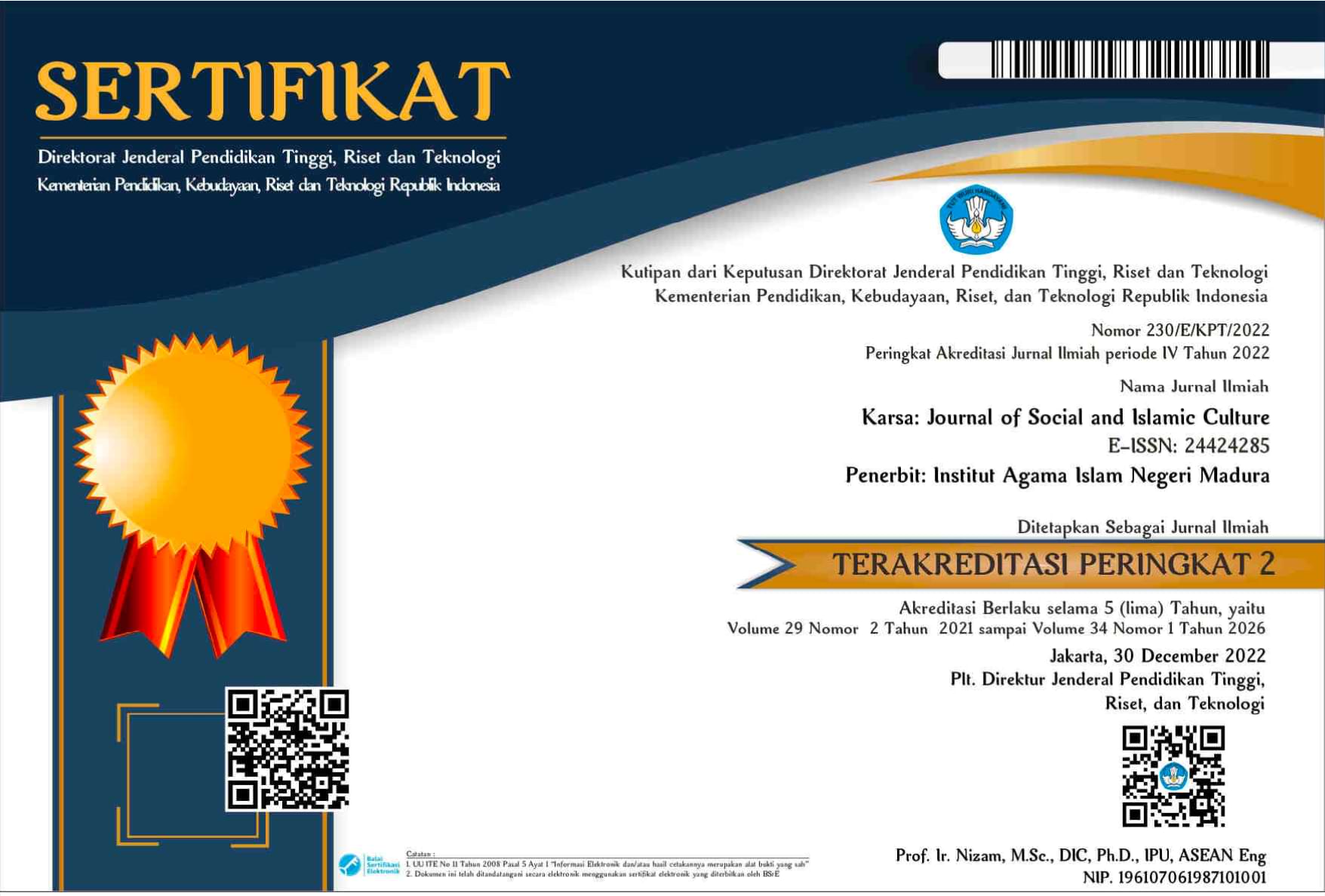The Symbolic Interaction of Tandhe’ in Sumenep Madurese
 Abstract views: 339
,
Abstract views: 339
,
 PDF downloads: 436
PDF downloads: 436
Abstract
Downloads
References
Abdullah, Haswah. Perkembangan Ilmu Tasawuf dan Tokoh-tokohnya di Nusantara. Surabaya: Al-Ikhlas. 2015.
Alifuddin, Muhammad. “Dakwah Berbasis Budaya Lokal Telaah atas Nilai-Nilai Dakwah dalam Folksong Orang Wakatobi.” Al Munzir 6, no. 1 (2013):72-89. https://ejournal.iainkendari.ac.id/almunzir/ article/ download/234/506.
Bernard, Raho. Teori Sosiologi Modern. Jakarta: Prestasi Pustaka. 2007.
Blumerand, Herbert, and George Herbert Mead. Pengantar Sosiologi Mikro. Translated by Agus Salim. Yogyakarta: Pustaka Pelajar. 2008.
Cahyono, Agus. “Pola Kewarisan Nilai-nilai Kesenian Tayub (Inheritance Pattern of Tayub Value).” Harmoni Jurnal Pengetahuan dan Seni 1, (Januari-April 2006). https://journal. unnes.ac.id/nju/index.php/harmonia/article/download/746/680
Chatib, Quzwain. Mengenai Allah, Suatu Studi Mengenai Ajaran Tasawuf Syaikh Abdus Samad Al-Palimbani. Jakarta: Bulan Bintang. 1985.
Dahlan, Abdul Aziz. “Pembelaan terhadap Wahdat Al-Wujud: Tasawuf Syamsudin Sumatrani.” Ulumul Qur’an 3, no.3 (1992).
Dwi Larasati, Evi. ”Bentuk dan Makna Simbolik Tayub Rukun Karya dalam Rangkaian Ritual Rokat Tase’ Masyarakat Desa Tanjung Selatan Kecamatan Saronggi Kabupaten Sumenep.” Jurnal Apron. https://jurnalmahasiswa.unesa.ac.id/index.php/apron/article/view/15556.
Elvinaro, Ardianto, and Bambang Q-Anees. Bambang. Filsafat Ilmu Komunikasi. Bandung: Simbiosa Rekatama Media. 2007.
Hadi W.M., Abdul. “Syekh Hamzah Fansuri.” Ulumul Qur’an 5, no. 4 (1994).
Hadi, Sumandiyo. Aspek-Aspek Koreografi Kelompok. Yogyakarta: Manthili. 1996.
Hamzah, Zayadi. “Islam dalam Perspektif Budaya Lokal: Studi Tentang Ritual Siklus Hidup Keluarga Suku Rejang.” PhD prop.diss. UIN Syarif Hidayatullah Jakarta, 2008.
Indriyanto, Paparan Mata Kuliah Analisis Tari. Semarang: Diklat Jurusan Seni Drama,Tari dan Musik Fakultas Bahasa dan Seni Universitas Negeri Semarang. 2012.
Jazuli, M. Pendidikan Seni Budaya Suplemen Pembelajaran Seni Tari. Semarang: Universitas Negeri Semarang Press, 2008.
Kuntowijoyo. Budaya & Masyarakat. Yogyakarta: Tiara Wacana Yogya. 1999.
Kusmayati, Hermien. ‘Arak-Arakan’ Seni Pertunjukan dalam upacara Tradisional di Madura. Yogyakarta: Tarawang Press. 2000.
Ma’arif, Bambang S. Komunikasi Dakwah, Paradigma untuk Aksi. Bandung: Remaja Rosdakarya. 2010.
Machmiyah, Siti. “Interaksi Simbolik Santri Pondok Pesantren Al-Amin.” Jurnal Kajian Ilmu Komunikasi 45, no. 1 (2015).
Miles, M.B, and A.M. Huberman. Analisis Data Kualitatif. Translated by Rohid Jakarta: UI Press, 1992.
Mukti Ali, Beberapa Persoalan Agama Dewasa Ini. Jakarta: Rajawali Press, 1987.
Mulyana, Metode Penelitian Komunikasi. Bandung: PT Remaja Rosdakarya, 2007.
Murgiyanto. A Primer for Choreographers (Jakarta: Lembaga Pendidikan Kesenian Jakarta. 1977.
Murgiyanto. Seni Menata Tari. Jakarta: Dewan Kesenian Jakarta. 1983.
Nawawi, Hadari, and Nini Martini. Penelitian Terapan. Yogyakarta : Gdajah Mada University Press. 1994.
Neuman, W. Laurence. Social Research Methods: Qualitative and Quantitative Approaches. Boston: Allyn and Bacon. 2000.
Nurhasanah, Een. “Nilai-Nilai Kearifan Lokal dalam Tiga Nyanyian Pembuka Pertunjukan Tari Jaipong.” Paper presented at Seminar Nasional Pendidikan FKIP UNTIRTA (2017). https://jurnal.un tirta.ac.id/index.php/psnp/article/view/431-436.
Ritzer, George, and Douglas J. Goodman. Pengantar Sosiologi. Jakarta: Penerbitan Fakultas Ekonomi Universitas Indonesia. 2004.
Rosmana, Tjetjep. “Kajian Cerita Rakyat Lampung.” Jurnal Penelitian 40, no. 2 (Agustus 2008).
Simuh. Sufisme Transformasi Tasawuf Islam ke Mistik Jawa. Yogyakarta: Yayasan Bentang Budaya. 1999.
Trimingham, J. Spencer. The Sufi Order in Islam. London: Oxford University Press. 1973.
The journal operates an Open Access policy under a Creative Commons Non-Commercial Share-Alike license. Authors who publish with this journal agree to the following terms:
- Authors retain copyright and grant the journal right of first publication with the work simultaneously licensed under a Creative Commons Attribution License that allows others to share the work with an acknowledgement of the work's authorship and initial publication in this journal.
- Authors are able to enter into separate, additional contractual arrangements for the non-exclusive distribution of the journal's published version of the work (e.g., post it to an institutional repository or publish it in a book), with an acknowledgement of its initial publication in this journal.
- Authors are permitted and encouraged to post their work online (e.g., in institutional repositories or on their website) prior to and during the submission process, as it can lead to productive exchanges, as well as earlier and greater citation of published work.





















